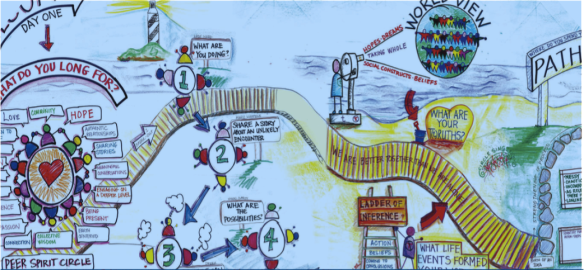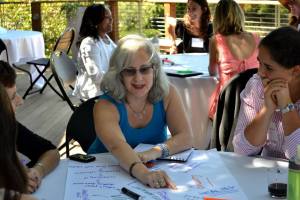What does it take for engagement – community engagement, organizational engagement, team and workforce engagement – to be successful? Recently, working with volunteers and staff at the United Way in Halifax the skills and requirements for successful engagement and what is at play when it doesn’t work so well were explored. We drew from both Shape Shift Strategies and United Way’s experiences to illuminate the points being shared with you now in this post, which focuses primarily on engagement through a meeting or gathering in the community or organization.

Intentionality of Planning Process
Strong engagement processes are not simply a matter of calling a meeting, sending out a notice and planning the agenda. Intentionality and thoughtfulness exist at each stage of the process. This intentionality includes clarity of need and purpose for the meeting, clarity about what success at the end of the day looks like, understanding who needs to be in the room, inviting them in a way they feel invited and designing a meeting process that elicits engaged participation.
Clarity on Need, Purpose and Outcomes
Understanding the need being addressed and the purpose of a meeting is a fundamental first step toward successful community or organizational engagement. Need and purpose may evolve over the course of the planning process, requiring the planning team to check back periodically to see if need and purpose are still clear. It is an iterative process. If there are multiple phases of planning or engagement, then clarity of need and purpose needs to be revisited at each phase.

In addition to understanding the purpose of the gathering, articulating the outcomes you are aiming for is important. Is the need for people with diverse perspectives to be in conversation with each other? If they have never been able to be in a conversation where they discover points of connectedness that help them work together on issues that matter, the conversations themselves might be the outcome. If there is a need or desire to create a plan, then articulating a plan may be the outcome. If an action strategy is needed, than well formulated next steps might be an outcome. The outcomes being aimed at will also help guide the planning and design process.
Who to Include When
In the end, it is pretty simple really. If it is about us, don’t do it without us. Who needs to be part of they process, why and at what phase? Sometimes engagement fails because the planning team is not representative of the community, the organization or the group intended to be engaged.
A well-crafted invitation for each of the intended audiences will have potential participants tuning in more fully, especially if they can see themselves in the invitation. This includes words and images. Who is doing the inviting and how can be just as important as what the invitation looks like. There are some people who have enough sway in a community or group to bring people in. Are these people part of your planning team?
If the people you want there are not responding to your invitation, it might not be that they don’t care enough – which is often the first assumption made. It might be that they don’t feel invited, valued or like their contribution will either be welcome or make a difference. Instead of assuming they don’t care, go back to the drawing board with your invitation and invitation process. Take the time to find out what it takes for people you want at your meeting to feel invited. It might mean you have to go talk to them and not rely on email or social media.
Authenticity of Intention
Even though you might be working with a purpose toward outcomes, the quality of intention with which this is done is fundamentally important to the success of your engagement. Is there a hidden agenda? Does the team, or do some team members, want to drive toward a pre-determined outcome and not to what wants to emerge from the group? If these issues are alive in the organization or the team or the meeting, engagement strategies will be flawed because participants will sense underlying dynamics and will more likely leave dissatisfied and even disgruntled.
An outcome of discovering what issues a community wants to pursue is a whole lot different than wanting the community to name the issues you already have on a list. Pretend engagement backfires. It generates mistrust and it is always hard to recover from that. However, if you have a list and you want community or organizational members to explore that list of issues so you can learn more, then, that could be a different story. Being clear about that up front changes again the nature of the engagement because the purpose and outcomes are different.
Design of the Meeting Process
A meeting process designed by a team will be stronger than one designed by an individual and it will have more support. An engaged team generates an energy about it that lends itself to an engaging atmosphere in your larger gathering, especially as team members hold a welcoming attitude for all who show up (even those people you might not be so thrilled to see).
The purpose of the meeting or gathering you are planning provides context for the design of the meeting or the agenda. When details overwhelm or sidetrack the planning process, tuning back into purpose will bring things back on track. Choices of methodologies, how they flow together and questions that guide the conversations are decided within the context of the purpose.
 You may like to draw on a pattern like divergence-emergence-convergence to both inform your initial design and remind your planning team of the natural pattern of human dynamics that do show up in most community and organizational gatherings.
You may like to draw on a pattern like divergence-emergence-convergence to both inform your initial design and remind your planning team of the natural pattern of human dynamics that do show up in most community and organizational gatherings.
The team should be prepared to revisit and refine the design over a few meetings and take caution about becoming too attached to design flow or questions that have been formulated or to their own brilliance in the process. The less attached we are to our own brilliance the more likely the brilliance of each team member will show up and the more collaborative the team will likely be. When there is time, allowing things to gestate and gel often improves initial thought processes so revisiting design with the intent to improve can impact the quality of the meeting.
Be mindful of the language you use. Will it resonate with your community or your organization? What is the balance between using language intentionally to shift habitual patterns in a group and using language the group recognizes and will respond to? Know your audience.
Working with Partners – Don’t Host Alone
There are times when the human dynamics challenges have been deeply entrenched in a community or an organization. When those patterns have been reinforced over and over again in many ways, they can be hard to disrupt. Anyone trying to lead or host alone becomes an easy target for transference or projection. Disruptive individuals or groups will sometimes try to assign blame or transfer responsibility to a facilitator or sole leader. This is much harder to do when there is a team hosting the engagement process. This is because leadership is shared and rotates. There are many eyes, ears and senses tuned into what is happening in a room – so more of the total picture is collectively known – and if any one person runs into trouble (projected on, trip over something in the room or something within them is triggered or activated), other hosts can step into leadership in those moments.
However, a cautionary note, if there are dynamics in the team – team members don’t get along, vie for status or other unresolved issues – they will show up in the larger group in one way or another. It is part of the work we must tend to around shadow.
Collaborative Leadership, Guidance and Letting Go
There is a difference between letting go of control and letting go of leadership. Collaborative strategies do not mean there is no leadership, but leadership looks different. Sometimes it is “invisible” in how the meeting space or energetics are held by a team. Sometimes it is in the offering of a good question, a well-placed observation or the provision of a good process or set of processes. Sometimes it is in clarity of decision-making processes – who makes what decisions when. But letting go of control, of the meeting or conversation needing to be a certain way, allows for participants to be in the explorations that are important to them, allows them to be more engaged. Coaching your team for skills and process that encourage shared leadership, shared responsibility and engagement can make a big difference to understanding what it takes for collaborative leadership to succeed.
What Ideas Want to Advance?
Recognize that not all ideas will have enough energy, passion or commitment to advance. Let them go. It is not a sign of failure other than perhaps failure to pay attention to what is alive in the room. If it is your pet idea but nobody, including you, has enough enthusiasm to step up to leadership, it is not meant to be materialized in this moment. It might come back around later or elements of it might show up somewhere else. But be prepared to offer support for the ideas and people who do come forward. Sometimes there are competing priorities. If it is clear that this is what’s going on, then choices can be made with greater intentionality.
Celebrating and Communicating Success
Throughout the planning process you will want to identify what is the harvest, or documentation, that will help you share your message with intended audiences. Invitation is a form of harvest. Follow up reports. Social media sites. Initiatives moving forward. All forms of harvest. Who needs what information in what form? Share how the gathering met the purpose and outcomes – or didn’t. Share the success stories coming out of the work. Help people understand the wins and the work ahead. Remind people that in addition to small wins along the way, growing results, growing momentum and growing engagement takes time.
Oh. And, have fun! Relax into the process. Bring your most invitational and welcoming self and be prepared to be surprised.


















 You may like to draw on a pattern like
You may like to draw on a pattern like 

